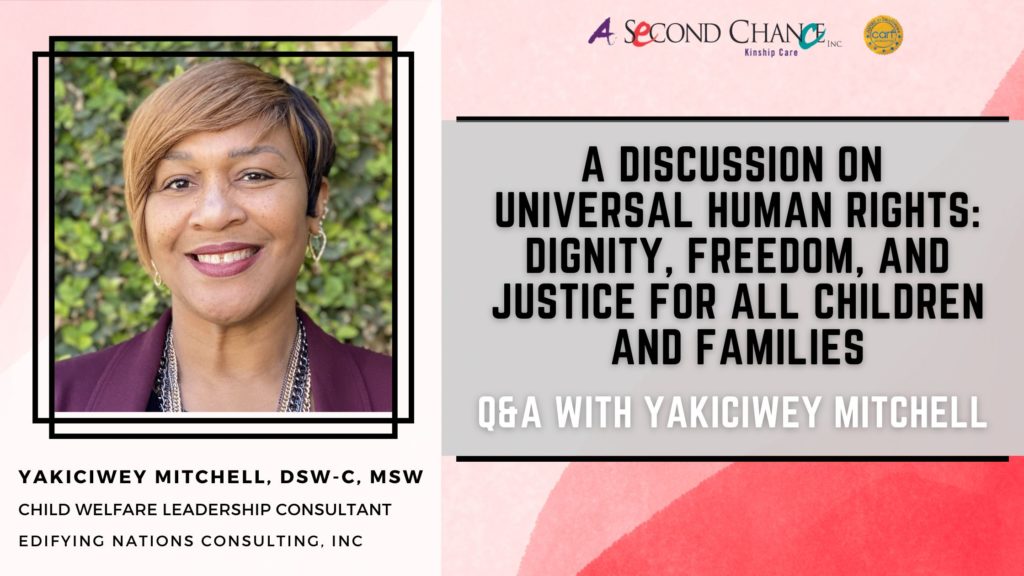Blog
Universal Human Rights: Dignity, Freedom, and Justice for all Children and Families
In the month of December, the Universal Declaration of Human Rights (UDHR) is recognized across the world. The UDHR was proclaimed by the United Nations General Assembly in 1948 and is recognized for paving the way for the adoption of more than 70 human rights treaties. This year’s theme is Dignity, Freedom, and Justice for All. While UDHR reflects all rights for humans it also provides rights for our children. We are constantly having conversations about why we should consider the best interest of the child. Unfortunately, the child welfare system has been stuck in these same conversations for decades with minimal change. As a system, we must continue to explore why kinship care is in the best interest of the child.
ASCI had the opportunity to speak with national child welfare leader, Yakiciwey Mitchell, to discuss the Universal Declaration of Human Rights as it pertains to protecting children, and why it is critical to protect families and seek Kin-First care.

What recent policies in child welfare have worked towards ensuring children and families maintain their human rights?
One piece of legislation and one international action come to mind. The first is the Families First Prevention Services Act (FFPSA) of 2018. FFPSA provides federal funding for some prevention services. Shifting resources to primary prevention of removal is promising, but only programs proven effective in preventing removals are eligible for the funding. This requirement could exclude effective practices that have not been identified or affirmed as promising, emerging, or evidence based. Still,FFPSA places emphasis on preventing removals, which is preferred when safely possible. The focus of child welfare systems should be on preserving family integrity and acknowledging that human beings have a right to their own families. The Black Administrators in Child Welfare (BACW) highlighted FFPSA as legislation that has the potential to provide critical support to marginalized families who would otherwise enter the child welfare system due to neglect.
The second action is the United Nations Committee on the Elimination of Racial Discrimination confronting the U.S. government about the separation of Black families via child welfare involvement. The hearing took place in August 2022, after Children’s Rights, and the Columbia Law School Human Rights Institute urged the Committee to act. Actions like this are critical because they keep the issue of the human rights of marginalized groups in child welfare on the minds of policymakers.
How has racial discrimination in child welfare violated the human rights of children and families of color?
The 14th amendment of the United States Constitution says that Americans have a right to keep their families intact. The U.S. economy, social strata, and the child welfare system were built on racist and genocidal foundations. Dettlaff & Boyd (2020) liken the disproportionate removal of African American children to the separation of Black families during slavery. These authors highlight the trauma that child removal and prolonged family separation cause, and assert that “…risks are heightened, resulting in a condition of compound disadvantage for youth who are already at increased vulnerability for negative outcomes. As such, for Black youth, foster care as an intervention becomes a source of their ongoing and continued oppression” (p 255).
Do you believe kinship care plays a part in protecting children and families under the UDHR? Why or why not?
In our Race Equity Strategy Areas (RESA), BACW lists strategies based on how they should be sequenced. We emphasize child neglect response (prevention) first, then effective parent engagement if child welfare is working to maintain a family. Thirdly, we emphasize community engagement for family support as a strategy to help connect families to natural supports within their communities. If a child/children must be removed, we urge child welfare agencies to engage kin early, effectively, and often. This means that the paternal side of the family is sought out when the family first comes to the attention of the system despite barriers to identifying them. ASCI’s Kin 2 You© framework highlights that the system misses as many as half the potential relative resources when it fails to engage children’s paternal side. Identifying and engaging kin is essential when removal is necessary, but it is not ‘one and done’, so to speak. Efforts to identify and involve kin must start at the outset and continue through the life of a child welfare case.
What is the significance of prioritizing kin-first placements over traditional foster care for children needing out-of-home care?
Kin-first is best practice from a trauma-informed perspective. Child removal and family separation are traumatic for children. Trauma is compounded the longer children are separated from family, and placement with relatives can reduce children’s trauma. We want to help children and families, not harm them, and it is in our power to help.